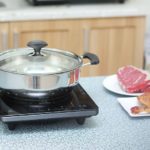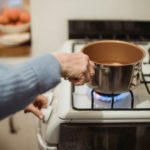Incompatible stove capacity with household voltage
If the electrical wiring in the house is small, it will be difficult to match the capacity of the induction stove (The power consumption of the induction stove is usually 1,800 – 2,200W), which poses a risk of fire and hazards. Before buying, mothers should carefully ask about the capacity of the stove to see if it is suitable for the household voltage.

Using the stove surface for food preparation
If you prepare food directly on the stove surface, the sand particles falling from vegetables, or when you chop coconuts or other heavy objects, can cause scratches on the stove surface. It’s best to only use the induction stove for cooking and not misuse it for other purposes.
Placing a wet pot on the stove surface
Calcium deposits can form if the calcium content in the water is high, and this often happens when you place a wet pot on the stove surface. Therefore, you should dry the pot thoroughly before cooking. If you still see calcium deposits on the stove surface, you can clean it with a suitable cleaning agent.

Leaving the stove on for too long and continuously
Using the stove continuously for a long time will overload the stove, causing the stove surface to crack, malfunction, and reduce the lifespan of the stove due to the high heat generated on the induction stove. When cooking dishes such as slow-cooked, porridge, stew… after finishing, we should let the stove rest for a few minutes before turning it on again to cook other dishes.
Blocking the airflow of the stove
Many people have the habit of placing the induction stove close to the wall or placing other objects too close to the stove, unintentionally blocking the airflow that helps cool the stove. The consequence is that the moisture generated during cooking will remain in the stove, causing circuit faults and internal damages. The best way is to not clutter things around the stove, and place the stove at least 5 – 10cm away from the wall.
Unplugging the stove immediately after cooking
Some people mistakenly believe that unplugging the induction stove immediately after cooking will save electricity, but it’s not true. When the power is unplugged, the stove’s cooling fan will no longer work, which slows down the cooling process of the stove; in the long run, it will cause the stove to deteriorate faster. Ladies should wait for the stove’s cooling fan to stop before unplugging it.
Using pots that are either too large or too small
Many people think that as long as the pot is not broken, it’s fine. In reality, using the wrong size pot will cause a variety of problems. You may take more time to cook the food, it’s harder to clean, or you have to pay more attention when cooking.
Therefore, you should choose pots and pans that are suitable in size, according to the principle of “matching the stove with the pot”. This strategic investment will ensure that the food is evenly cooked, prevent heat loss, save time and effort, and make the food more delicious.
Using more than one finger to press the control button on the stove
When using two or more fingers to press the button on the stove, it’s easy to accidentally touch 2-3 buttons, causing errors and malfunctions in the stove. Mothers should only use one finger to press and select the options one by one.
Not cleaning regularly
After a long day of work, just the thought of cooking is enough to make many people reluctant, let alone cleaning after cooking. And then, the dirt starts to accumulate and cling to the stove surface, making it inevitable to spend hours cleaning.
Using strong cleaning agents
Rough sponges or strong cleaning agents like oven cleaners are not suitable for the smooth and shiny surface of the induction stove, and they can even damage the stove surface.
Scrubbing too hard when cleaning the stove will do more harm than good, it can cause permanent scratches, making the stove surface less aesthetically pleasing.
In reality, with the super smooth glass surface of the induction stove, any dirt or food spills can be wiped clean immediately. So you don’t need to scrub hard, just wipe it with a soft cloth after each use.
Source: Khoevadep
How much electricity does an induction cooktop consume per month? Is it worth using an induction cooktop?
With the skyrocketing cost of living in today’s world, many families are hesitant when it comes to buying induction cookers. They wonder if induction cookers consume a lot of electricity compared to gas stoves. What are the outstanding advantages of induction cookers? The initial investment cost for induction cookers is also quite high, so careful consideration is needed before making a decision. In this article, Meohay will share information about the electricity usage of induction cookers, as well as the pros and cons, so that you can make the best choice.


































